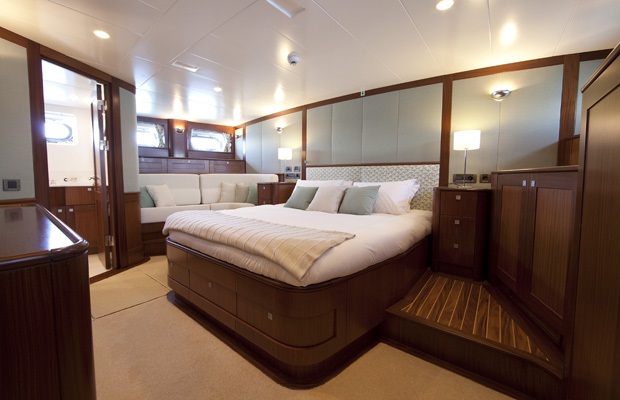Kestrel Superyachts was founded by an Irish husband and wife in search of a sailing yacht that that say they couldn’t find. They wanted one that looked traditional, performed comparably to other modern sailing megayachts, and bore copious entertaining space. And, equally important, they wanted a sailing yacht that was “genuinely family-friendly, especially for people unfamiliar with yachts,” explains Peter Cooke, the husband. “We found people built the yacht of their dreams but left their family behind.” By this, he means men who commission projects while their wives just select curtains or, worse, situations where families falling overboard due to the heel of the yacht.
It took six years of planning and gathering a team of investors, many of whom are experienced yacht owners, engineers, and/or have vetted yacht layouts previously. It also took meeting Ron Holland of Ron Holland Design. Enter the first Kestrel Superyachts launch, the Kestrel 106 Kestrel. She’s what the Cookes call a “both worlds” megayacht, combining generous entertaining and relaxation spaces with sailing amenities and performance that reward sailors and non-sailors alike.

Built by the Aganlar boatyard in Bodrum, Turkey, the all-aluminum Kestrel was “a stimulating project” for Holland. “Here was an initiative to create a yacht that could be equally at home undertaking a luxury charter in the Eastern Mediterranean or long-distance passage making in the open ocean,” he says. “We are delighted with the result. This is a very attractive yacht that really does challenge conventional wisdom by demonstrating that you can have exceptional amenity without prejudice.”
To that point, Kestrel has four staterooms for the Cookes and guests. The full-beam owner’s cabin is the star, something you’d expect to see on a 120- to 140-foot megayacht, not a 106-footer. Further, the twin guest stateroom also has pullmans, taking total capacity to 10 people, more than the usual six to eight. Even with these owner and guest amenities, crew get two twin cabins and a workable galley, none of which seem compromised. A concession was made in the engine room in terms of it being a crawl-in space, but the single Skania and two gensets are fully accessible.
While the deck saloon is airy, thanks to great headroom, the best place to be is out in the cockpit. Tables and benchseats can remain outboard or slide to amidships for dining, depending on the size of the crowd. With the seating outboard, the tables can be removed for dancing. Yes, dancing—the Cookes had the original stars of Riverdance perform onboard Kestrel during the Antibes Yacht Show, to onlookers’ great delight. The fact that the deck is clear of winches and other equipment underscores the concept of catering to non-sailors. (Sail-handling gear is, obviously, within reach of the helmsman, positioned forward to port.)
Equally important for non-sailors and sailors alike is how Kestrel handles. Cooke says he and his wife are delighted that Kestrel has an easy motion at sea, sailing at a more upright 15 degrees than other sailing yachts. In addition, the inclusion of a clipper bow with huge flare serves to soften the ride and keep her dry. This came in handy during a cruise in April from Antibes, France to Genoa, Italy for the annual Genoa Charter Show. Conditions that Cooke calls “lively” involved winds upwards of 30 knots and breaking waves from astern. Even with these, Cooke says Kestrel rode softly and remained mostly dry, topping out at 13.8 knots, her fastest so far.
Kestrel is available for sale through Watkins Superyachts for €7.5 million (about $9.385 million). She’s also available for charter through Select Charter Services for €49,000 (about $61,316) per week. Cooke says other models of Kestrel Superyachts are in the works, too.
Enjoy this closer look at Kestrel.










Leave a Reply